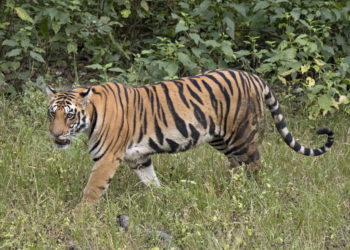KATHMANDU: On the afternoon of August 16, a sudden flood struck Thame in the Khumbu Pasang Lhamu Rural Municipality of Solukhumbu, catching residents off guard.
The locals never expected such an abrupt deluge, and in an instant, their village was transformed into a swamp.
For Tashi Lhamu Sherpa, President of the Khumbu Pasang Lhamu Rural Municipality, that day feels surreal. “We are in the grip of climatic risks,” Tashi says.
“The residents here are anxious about when they might become victims of an avalanche.”
Many people are still reeling from the devastation caused by heavy rains that swept across various regions, including the Kathmandu Valley, on September 27, 29 and 29.
According to statistics from the National Disaster Risk Reduction and Management Authority, 250 people lost their lives over those three days, with 18 still missing and 178 injured. Nearly 6,000 private residences have suffered damage.
The Ministry of Agriculture and Livestock Development reports that rice production is expected to decline due to the heavy rains that coincided with the farmers’ preparations for harvest.
Before seeking access to financial support for climate-related damages, Joshi emphasized the need for a clear understanding of what Nepal could have done to mitigate these impacts.
Three years ago, unseasonal floods caused nearly eight billion rupees in damages to rice production.
In a similar incident three years ago, just a week into the monsoon season, the Melamchi Water Supply Development Committee reported significant damage to the Melamchi Water Supply Project due to flooding in the Melamchi and Indrawati rivers in Sindhupalchowk district.
The joy of residents in the Kahtmandu Valley, who had awaited Melamchi water for nearly three decades, was swiftly overshadowed by the devastating flood.
As a result, the project now has to close during the rainy season and operate only in the winter.
According to the National Disaster Risk Reduction and Management Authority, this year, 495 people have lost their lives due to monsoon-related disasters, with 66 individuals still missing and 522 injured in one year.
Numerous other climate-related hazards persist. The 29th Conference of the Parties (COP-29) of the United Nations Framework Convention on Climate Change (UNFCCC) began today in Baku, Azerbaijan, and will run until November 22.
Meanwhile, President Ram Chandra Paudel is representing Nepal at the conference.
During this year’s COP, he will advocate for the protection of mountains and the planet.
The President’s Secretariat has organized a program for him to prioritize mountain security in discussions with heads of state and senior officials from over 192 countries, highlighting examples of increased risks caused by climate change.
Dr. Sindhuprasad Dhungana, Head of the Climate Change Management Division at the Ministry of Forests and Environment, stated that various disaster events related to climate conditions will be presented at the conference.
“We will showcase unseasonal disasters, avalanches, and catastrophic events,” he said, emphasizing the need to advocate for financial assistance for climate-related damages.
He noted that to implement the government’s second Nationally Determined Contribution (NDC) and National Adaptation Plan (NAP), international climate finance, capacity building, and technology are essential, making climate finance a top priority this year.
“On September 27 and 28, relentless rain led to unexpected flooding and landslides in many areas. The sudden flood in Thame of Khumbu Pasanglhamu Rural Municipality caused billions in damages, and Mustang experienced flooding for the first time,” he stated.
“A few years ago, the Melamchi river flood also damaged the project. Climate change is exacerbating these impacts,” he said.
“We are facing disasters due to melting glaciers and avalanche risks, so we will demand necessary climate finance from the countries most responsible for climate change.”
Kamalraj Joshi, Director General of the Department of Meteorology, warned that 47 large glaciers are at risk, and if they break, Nepal could face billions in economic and human losses.
The Ministry of Forestry and Environment has prepared six thematic working papers focused on climate finance, climate-related damage, carbon trading, emissions measurement, mountain issues, technology and capacity building, and climate change adaptation.
“Of the endangered glaciers, 25 are in China, 21 are in Nepal, and one is in India,” he noted. “Investment must increase to mitigate the risks posed by these glaciers.
This year, we will continue studying the causes of the avalanche in Thame.”
Before seeking access to financial support for climate-related damages, Joshi emphasized the need for a clear understanding of what Nepal could have done to mitigate these impacts.
“We cannot claim that climate change is solely responsible without conducting in-depth studies. Effective preparation is essential to reduce disaster-related damage, which would strengthen our case for international financial assistance,” he explained.
Climatologist Manjit Dhakal added that showcasing vivid examples of climate-related risks would bolster Nepal’s agenda at the conference.
Advocacy to reduce climate-related risks
Recent research by the Asian Development Bank (ADB) indicates that climate change could reduce gross domestic product (GDP) in developing Asia and the Pacific by 17 percent by 2070.
A study by the International Center for Integrated Mountain Development (ICIMOD) found that the impact of climate change on the Hindu Kush Himalayan region is three times greater than the global average.
ICIMOD reports that glacier melting has increased by 65 percent from 2011 to 2020 compared to the previous decade.
Developing countries, including Nepal, are preparing to advocate for global action to mitigate the impacts of climate change on mountainous regions and reduce other climate-related risks.
COP-29 agendas
Nepalese representatives have prioritized six main agendas to address climate risks and promote national welfare at COP-29.
The Ministry of Forestry and Environment has prepared six thematic working papers focused on climate finance, climate-related damage, carbon trading, emissions measurement, mountain issues, technology and capacity building, and climate change adaptation.
“We have also prepared Nepal’s national position paper for COP, which includes concepts on climate adaptation, climate finance, agriculture and food systems, health and climate change, energy transition and efficiency, water and climate action, and nature-based solutions,” said Dr. Buddhi Paudel, Joint Secretary of the Ministry.
Efforts are underway to advocate for the effective implementation of the Climate Damage Fund, established at COP-28 in Dubai last year.









Comment